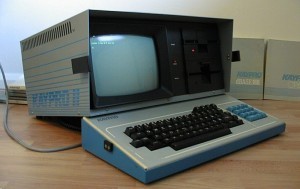A Theory of Love
 I remember sitting in red tights and buckled shoes in my childhood room as my word processor booted up. My father had taught himself DOS programming, and boxy yellow letters blinked on the gray green screen. “THIS IS KATIE RYDER’S WORD PROCESSOR. HELLO KATE.” A system-check flashed through my existing files—“/a_bad_day” (child minimalist), “/last_unicorn” (child plagiarist)—before bringing me to the composition page. My dad’s words changed slightly from week to week by mysterious means; this time, they declared: “YOU’RE READY TO WRITE KATE.”
I remember sitting in red tights and buckled shoes in my childhood room as my word processor booted up. My father had taught himself DOS programming, and boxy yellow letters blinked on the gray green screen. “THIS IS KATIE RYDER’S WORD PROCESSOR. HELLO KATE.” A system-check flashed through my existing files—“/a_bad_day” (child minimalist), “/last_unicorn” (child plagiarist)—before bringing me to the composition page. My dad’s words changed slightly from week to week by mysterious means; this time, they declared: “YOU’RE READY TO WRITE KATE.”
In Scott Hutchins’s debut novel, A Working Theory of Love, Neill Bassett Jr. communicates with his dead father through a computer. Dr. Neill Bassett Sr. committed suicide while his son was in college and left behind a tome of meticulous journals. These—painstaking and only superficially personal—are used to form the base “personality” of a computer run by a small team of scientists aiming to develop the world’s first “sentient” machine, by the standards of the Turing test. Neill’s task is to “chat” with DrBas, as the program is called, and work out the kinks, training the computer in the rules of language and interaction. Soon it begins to demonstrate inclinations and preferences—something a bit like a will—and DrBas comes to closely resemble Neill’s dead father. The two talk of Neill Sr.’s best friend; his wife, Libby; Neill Jr.’s childhood and current life—a recent divorce and a new, stunted romance with a much younger woman—all the while skirting the black hole of the computer’s knowledge: that the real Dr. Bassett killed himself in 1995, that the person Dr. Bassett is dead.
Meanwhile, in the real world, inventor and futurist Ray Kurzweil has stored a warehouse room full of information about his own dead father for the purpose of bringing him back to life as an electronic consciousness. The chief inventor of the flatbed scanner and the Kurzweil keyboard synthesizer, and a millionaire many times over, Kurzweil described the Internet before its existence and accurately projected the year a computer would defeat a human chess champion. He now predicts computers will reach sentience by 2029—a point at which they will “match human intelligence and go beyond it.” This moment is sometimes referred to as the singularity—a mythic, multipurpose term, borrowed from physics and mathematics. At its most basic, the singularity is the moment when “the model breaks down”: when we can no longer know what we knew before. In a 2009 documentary about Kurzweil called Transcendent Man, Ray explains that he will live forever (through transhumanistic nanotechnology: microscopic machines that will aid in “reprogramming” our “Version 1” bodies to more perfect health), and, he says, eyes into the camera, “I do plan to bring back my father.” Fred Kurzweil’s letters, sheet music, financial ledgers, and electric bills all sit in wait. Read More »
The Paris Review's Blog
- The Paris Review's profile
- 305 followers



